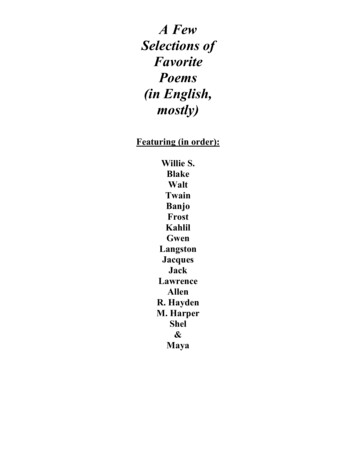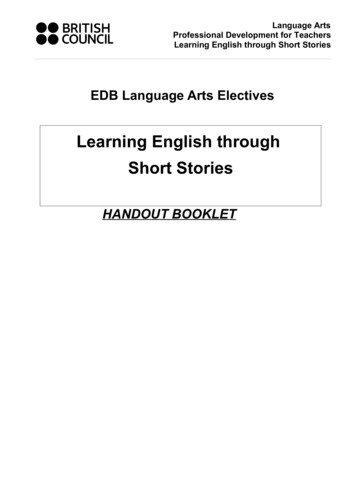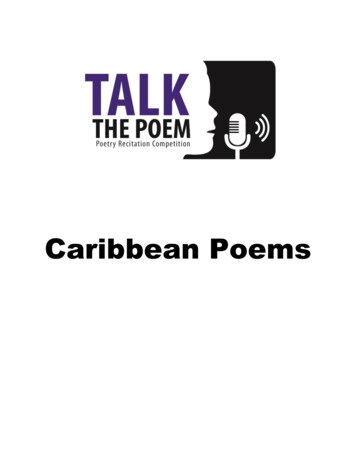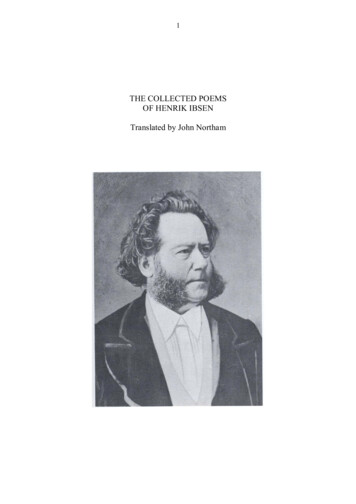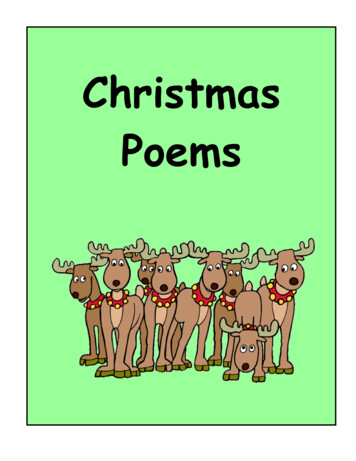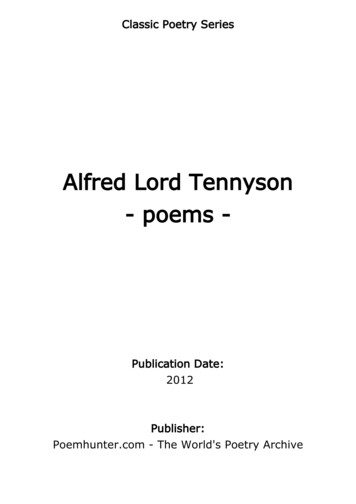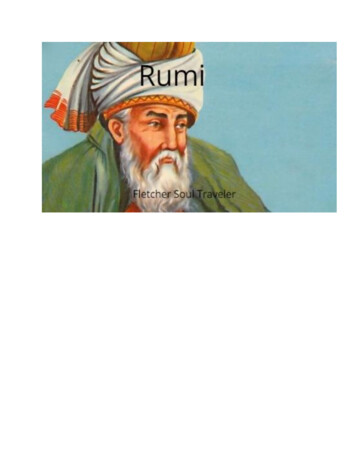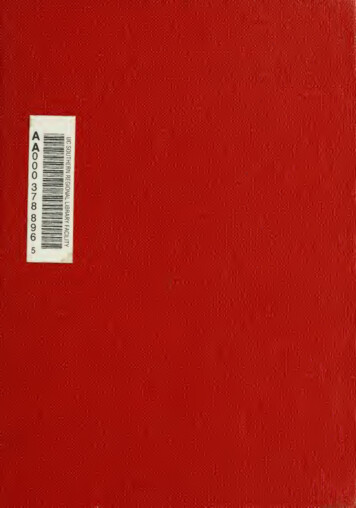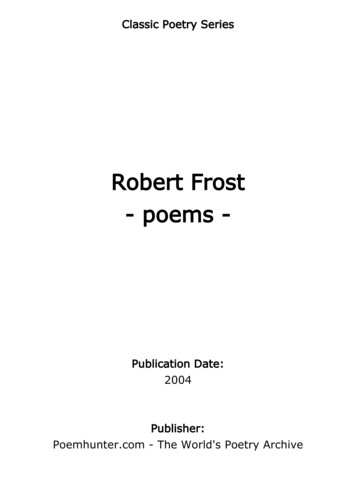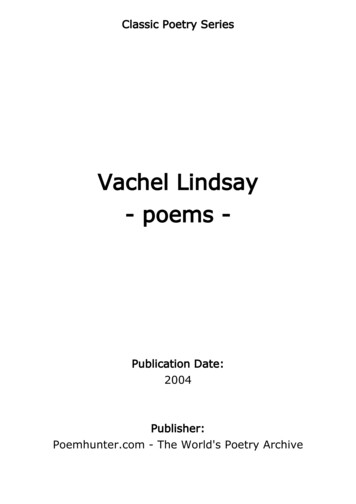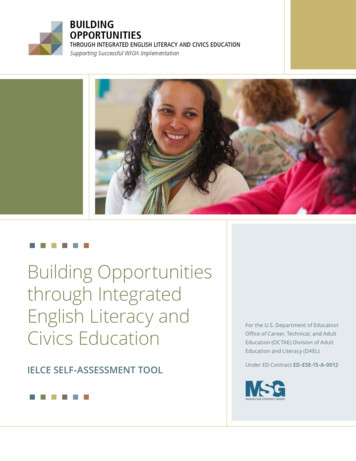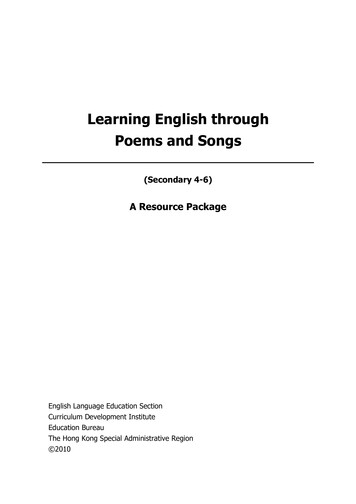
Transcription
Learning English throughPoems and Songs(Secondary 4-6)A Resource PackageEnglish Language Education SectionCurriculum Development InstituteEducation BureauThe Hong Kong Special Administrative Region 2010
English Language Education SectionCurriculum Development InstituteEducation BureauThe Hong Kong Special Administrative Region12th Floor, Wu Chung House, 213 Queen's Road East, Wanchai, Hong KongFirst published 2010All rights reserved. The copyright of the materials in this resource package, other than thoselisted in the Acknowledgements section (page iv) and those in the public domain, belongs tothe Education Bureau of the Hong Kong Special Administrative Region.Duplication of materials in this package other than those listed on page iv and those in thepublic domain is restricted to non-profit making educational purposes only. Otherwise, no partof these materials may be reproduced, stored in a retrieval system, or transmitted in any formor by any means without the prior permission of the Education Bureau of the Hong KongSpecial Administrative Region.ISBN: 978-988-8040-65-0
ContentsPagePREFACEiACKNOWLEDGEMENTSivSTUDENT’S HANDOUTSPart 1:Module IntroductionS1Part 2:Introduction to Poems and SongsS7Introduction to PoetryS8Characteristics of English PoetryS10Appreciating Poems and SongsS17Reading and Writing PoetryS29AcrosticsS30Shape PoemsS33Poems Making Use of Different Grammatical PatternsS36LimericksS42HaikuS45Narrative PoemsS50BalladsS56Appreciating Songs and Writing Song LyricsS59Song Lyrics Reading and WritingS60Song Presentation for CommercialsS63Musical Appreciation and Performing a SongS67Presentation on Poem or SongS72Planning and Organising Your PresentationS73Sample PresentationsS74Part 3:Part 4:Part 5:TEACHER’S NOTESPart 1:Module IntroductionT1Part 2:Introduction to Poems and SongsT6Part 3:Reading and Writing PoetryT22Part 4:Appreciating Songs and Writing Song LyricsT49Part 5:Presentation on Poem or SongT65SUPPLEMENTARY MATERIALSVocabulary Challenge: “Rain”T71Grammar Challenge: Grammar TermsT73Quick Quiz: “As X as Y” ExpressionsT74Appreciating Different Types of PoetryT76Appreciating the Musical Oliver! (I)T100Appreciating the Musical Oliver! (II)T102Appreciating the Musical Oliver! (III)T104
Learning English through Poems and SongsPrefaceThis resource package is designed and developed in support of the English LanguageCurriculum and Assessment Guide (Secondary 4 – 6) (2007) and the Suggested Schemes ofWork for the Elective Part of the Three-year Senior Secondary English Language Curriculum(Secondary 4 – 6) (2007) . It provides learning resources and teaching ideas for thedevelopment and implementation of the elective module “Learning English through Poemsand Songs”.AimsThe rationale behind the package is that students will have ample opportunities to enrichtheir English learning experience and extend a range of language abilities through exploringpoems and songs. Carefully designed and sequenced, the materials and activities in thispackage aim to:strengthen students’ skills of understanding and appreciating the themes, structures,features and language in a range of poems and songs;help students to respond to and give expression to the imaginative ideas, moods andfeelings expressed in poems and songs through written, oral and performance means;andenable students to apply the knowledge and skills they have learned in their own creativeproduction and critical appreciation of poems and songs.How to use this resource packageThis resource package comprises student’s handouts, teacher’s notes, supplementarymaterials and a CD-ROM. It covers the key focuses suggested in the SoWs for the moduleorganised under five parts, i.e. “Module Introduction”, “Introduction to Poems and Songs”,“Reading and Writing Poetry”, “Appreciating Songs and Writing Song Lyrics” and“Presentation on Poem or Song”. The first part gives students an overview of the aims andrequirements of the module as well as the purposes of the Poem and Song Journal thatstudents are encouraged to keep. In the second part, students learn to identify, understandand appreciate the features, structures, language and themes of English poems and songs.The third part exposes students to different types of poems including acrostics, shape poems,poems making use of different grammatical patterns, limericks, haiku, narrative poems andballads. Apart from allowing them insights into their characteristics, purposes and effects, itencourages free expression and personal responses through engaging students in writingand performing poems. In the fourth part, students explore the meanings, language andfeatures of the lyrics of some pop songs, commercial jingles and musical numbers. They willFrom this point forwards referred to as SoWsi
Learning English through Poems and Songsalso develop the skills to write their own lyrics and perform a song. Towards the end of themodule, students are given the opportunity to demonstrate their critical understanding of oneor more poems or songs as well as their knowledge and experience gained from the modulethrough presentations and display of their Poem and Song Journals. Given the range oflearning activities in this package, teachers are encouraged to exercise careful planning, beselective about the materials and freely adapt them to suit their school contexts and students’needs, interests and abilities.Student’s HandoutsThe student’s handouts (indicated by the page number prefix “S”) provide learningmaterials which enable students to understand and appreciate the themes, language andfeatures of a range of poems and songs which will develop their integrated language skills,cultural awareness, critical thinking and creativity.Teacher’s NotesThe teacher’s notes (indicated by the page number prefix “T”) provide explanations ofteaching steps and alternative teaching suggestions as to how to carry out the activities.Where appropriate, teachers may feel free to select and flexibly adapt the activities intoassessment tasks to promote learning and teaching.To help teachers to support “less advanced students” and stretch “more advancedstudents”, additional suggestions are contained in “Catering for Learner Diversity”boxes. Suggested time allocations have been provided for each activity for teachers’reference during lesson planning. However, the suggested time is for indicative purposes onlyand will vary according to learners’ needs and abilities. Teachers should use their professionaljudgement to gauge appropriate timings with a particular group of learners in mind.References to websites that contain materials helpful to the learning and teaching ofparticular activities are also included in the teacher’s notes. The weblinks or addresses whichwere accurate at the time this package was published are yet subject to change. Teachersmight like to make use of a search engine to regain access to any resources that have beenrelocated, or may look for similar resources on the web.Supplementary MaterialsThe supplementary materials section provides additional teaching materials andresources for teachers’ use and reference. The following items are included in this section:Supplementary vocabulary and grammar activities related to individual activities inthe package are included. Teachers are encouraged to select those that are suitable for theirstudents for consolidation and extension purposes.ii
Learning English through Poems and SongsSupplementary activities on appreciating different types of poetry provide a broadrange of linguistically rich learning resources to develop students’ language skills. Theselection of poems in this section, presented in alphabetical order, includes additionalmaterials to Part 3 “Reading and Writing Poetry” as well as poem types not coveredelsewhere in the package. Teachers could select the types of poetry and activities to cater forstudents’ diverse interests, abilities and needs.Supplementary activities on appreciating Oliver! cover songs in the musical notincluded in Part 4. A variety of tasks and an inventory of questions are provided to deepenstudents’ knowledge and skills in appreciating various aspects of the musical. They also serveas a reference for teachers to develop materials for other songs and musicals deemedsuitable for their students.CD-ROMThe CD-ROM consists of an electronic version of the learning and teaching materials in thisresource package, as well as recordings that support some of the learning activities in thepackage. The text files are available in both PDF and MS WORD formats for teachers’ ease ofuse and adaptation. The audio recordings in the CD-ROM include examples of poetry readingand advertising jingles that illustrate the use of stress, rhythm, rhyme and a range of basicliterary techniques used in English poetry and songs. There are also three audio recordingsand one PowerPoint file on individual presentations to demonstrate effective deliverytechniques. Track numbers of the recordings as well as information on the PowerPoint file areprovided in the explanations for relevant activities as well as on the cover page of each unit inthe teacher’s notes.To further support the implementation of the module, other relevant online teaching resourcematerials for each module have been developed and can be accessed at the EnglishLanguage Education Section website http://cd.edb.gov.hk/eng .iii
Learning English through Poems and SongsAcknowledgementsWe are most grateful to Mr. Philip Leetch for his expert input in designing the materials andactivities for this resource package.We are also much obliged to the following poets for permission to reproduce copyrightmaterials:Nicholas Gordon for the poems “On Passing Air” and “I Know It’s Only Half a Year”Myra Cohn Livingston for the poem “Swimming Pool”Kenn Nesbitt for the poem “I’m Feeling Rather Full Tonight”iv
Learning English through Poems and SongsThis is a blank page.v
Part 1Module Introduction
Learning English through Poems and SongsIntroductionWarm-up ActivityFavourite poems/songs1. Work with a partner. Make a list of three to five poems and songs (in either English or Chinese)which you like. Do they have anything in common? What do you think makes poems and songsgood? Be ready to share your views with the class.2. Listen to a poem your teacher reads. Work with a partner and decide what your reaction to it is.Do the feelings and/or words please you?3. Listen to a song your teacher plays. Work with a partner and decide what your reaction to it is.Do the feelings, words and/or music please you?S2
Learning English through Poems and SongsPoem and Song JournalThe purpose of this journal activity is to encourage you to access poems and songs as anindependent language learning activity. In parallel to what you will be doing in class for the module,collect five pieces of work (including both poems and songs) that you like and give your personalresponse to them.Include the following in the Journal for each of the five poems or songs: The poem or the song lyrics A description of the theme of the poem or song Language that you have learned from it(e.g. vocabulary, metaphors, similes, expressions) Your personal response to the poem or song(e.g. Did you like it? Why or why not? What did the poem or song mean to you?)The Journal will be used to assess your participation in the module and the progress you make duringit. It should also be something of value to yourself as a reflection of your taste, and something youcan share with others.The entries can be of different lengths. Some examples are given below for your reference.Journal Entry 1I just heard a funny song. It’s really crazy: an old woman swallows a fly. She wants to get rid of thefly so she swallows a spider to catch the fly and so it goes on until she swallows a horse!Of course, each verse gets longer as she swallows more things. Here are the seventh and eighthverses.There was an old lady who swallowed a cow.I don’t know how she swallowed a cow!She swallowed the cow to catch the goat.She swallowed the goat to catch the dog.She swallowed the dog to catch the cat.She swallowed the cat to catch the bird.She swallowed the bird to catch the spiderThat wriggled and jiggled and wiggled inside her.She swallowed the spider to catch the fly.But I dunno why she swallowed that fly.Perhaps she’ll die.There was an old lady who swallowed a horse –She’s dead, of course.Excellent ending!S3
Learning English through Poems and SongsJournal Entry 2My auntie, who studied in Canada, has introduced a little old poem to me. She had to explain it, butthen I decided I liked it a lot.Cherry-RipeCherry-ripe, ripe, ripe, I cry,Full and fair ones; come and buy.If so you ask me whereThey do grow, I answer: ThereWhere my Julia’s lips do smileThere’s the land, or cherry-isle,Whose plantations fully showAll the year where cherries grow.Robert HerrickThe poet is selling cherries in the street (it’s just like the opening scene in the second part of Oliver!and the song “Who will buy?”). If anyone wants to know where the cherries come from, he has hisanswer ready: from Julia’s lips.Lovers like to praise each other. Imagine going through your lover’s face. “Your hair’s like silk. Yourskin is like the outside of a ripe peach. Your eyes are like clear rock pools in the mountains. Yourlips are like cherries.” Why cherries? Because they are sweet, bright red and full of flavour, just likethe lips of his Julia who he would love to kiss!A charming poem.S4
Learning English through Poems and SongsJournal Entry 3I have just found these haiku in a school magazine in the school library. They have impressed me agreat deal.Cold wind; cloudy sky;Damp, grey: rain ready to fall –But bright red New Year!Sapphire sky; bright sun;School picnics in country parks –Time of youth and joy.The two poems refer to two different times of year in Hong Kong: the cold season and the drysunny season.The first haiku belongs to February. Th
development and implementation of the elective module “Learning English through Poems and Songs”. Aims The rationale behind the package is that students will have ample opportunities to enrich their English learning experience and extend a range of language abilities through exploring poems and songs. Carefully designed and sequenced, the materials and activities in this
